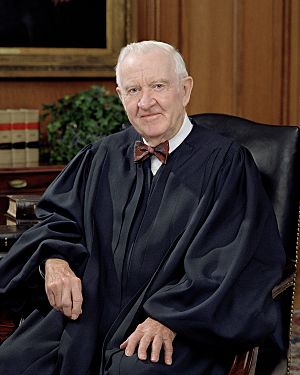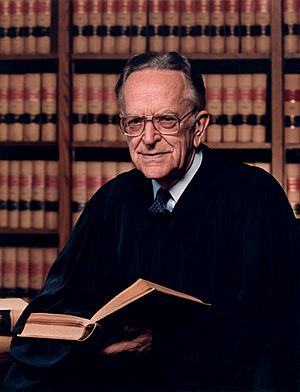South Carolina v. Catawba Indian Tribe, Inc. facts for kids
Quick facts for kids South Carolina v. Catawba Indian Tribe, Inc. |
|
|---|---|

|
|
| Argued December 12, 1985 Decided June 2, 1986 |
|
| Full case name | South Carolina v. Catawba Indian Tribe, Inc. |
| Docket nos. | 84-782 |
| Citations | 476 U.S. 498 (more)
106 S. Ct. 2039; 90 L. Ed. 2d 490, 54 U.S.L.W. 4544
|
| Prior history | 718 F.2d 1291 (4th Cir. 1983), affirmed on rehearing, 740 F.2d 305 (4th Cir. 1984) (en banc); cert. granted, 471 U.S. 1134 (1985) |
| Subsequent history | On remand, 865 F.2d 1444 (4th Cir. 1989) (en banc); cert. denied, 491 U.S. 906 (1989); mandamus denied after remand sub nom. In re Catawba Indian Tribe of S.C., No. 89-2831 (4th Cir. 1990) (en banc); aff'd in part, rev'd in part, vacated and remanded, 978 F.2d 1334 (4th Cir. 1992) (en banc); cert. denied, 507 U.S. 972 (1993); mandamus denied after remand sub nom. In re Catawba Indian Tribe of S.C., 973 F.2d 1133 (4th Cir. 1992) (en banc). |
| Holding | |
| State statutes of limitations apply to the land claims of terminated tribes | |
| Court membership | |
| Case opinions | |
| Majority | Stevens, joined by Burger, Brennan, White, Powell, Rehnquist |
| Dissent | Blackmun, joined by Marshall, O'Connor |
| Laws applied | |
| Treaty of Fort Augusta; 25 U.S.C. §§ 931—938 (termination act); Nonintercourse Act | |
South Carolina v. Catawba Indian Tribe, Inc. was an important case decided by the United States Supreme Court in 1986. It was about land claims made by the Catawba Indian Tribe in South Carolina. The main question was whether a state's "statute of limitations" (a time limit for filing a lawsuit) could apply to the tribe's claim.
The Court decided that state time limits could apply to land claims from tribes that had been "terminated." A terminated tribe is one where the U.S. government ended its special relationship and protections. The Court sent the case back to a lower court to figure out if South Carolina's time limit actually stopped the Catawba's claim.
The case went back and forth in the courts many times. In the end, the Catawba Tribe and the state of South Carolina reached a settlement. The tribe gave up its claim to the land in exchange for $50 million. This money helped the tribe rebuild and support its members.
Contents
History of the Catawba Land Claim
Early Land Agreements
The Catawba Indian Tribe lived in what is now North and South Carolina. In 1763, after the Royal Proclamation of 1763, the Treaty of Fort Augusta was signed. This treaty promised the Catawba Tribe about 144,000 acres of land in South Carolina. This was their only reservation, as they had given up other land claims to the British.
Land Sales and State Involvement
By 1840, most of the Catawba's reservation land was being rented out to non-Native Americans. After the American Revolution, a federal law called the Nonintercourse Act was passed. This law said that Indian lands could only be sold with the approval of the U.S. Congress.
However, in 1840, South Carolina bought the 144,000-acre tract from the Catawba Tribe with the Treaty of Nation Ford. The U.S. government was not involved in this sale. The tribe was supposed to receive some land, cash, and yearly payments. In 1842, the state bought a smaller 630-acre reservation for the tribe.
Federal Involvement and Termination
For many years, the Catawba Tribe tried to get the state and federal governments to resolve the land dispute. In 1943, the tribe, the state, and the Bureau of Indian Affairs (BIA) made an agreement. The state bought 3,434 acres for the tribe, and the land was held in trust by the U.S. government for the tribe. This agreement did not make the Catawba Tribe give up their original land claim.
In 1959, the U.S. Congress passed a law to "terminate" the Catawba Tribe. This meant the federal government would no longer have a special relationship with the tribe. The BIA told the tribe that this termination would not affect their land claim against the state. The termination law also said that all state laws would apply to the tribe, just like they applied to other citizens.
By the time the lawsuit started, the town of Rock Hill, South Carolina had grown up within the original 144,000-acre land area.
The Lawsuit Begins
Catawba Tribe Sues South Carolina
In 1980, the Catawba Tribe sued the state of South Carolina and many landowners. The tribe argued that the 1840 Treaty of Nation Ford was not valid because Congress had not approved it, as required by the Nonintercourse Act. The tribe wanted their land back and money for 140 years of damages. The Native American Rights Fund (NARF) helped the tribe with their case.
The local federal judges could not hear the case, so a judge from Pennsylvania, Judge Joseph Putnam Willson, was assigned to it. He decided that the state's time limit (statute of limitations) applied and that the Catawba's claim was too late. He ruled in favor of the landowners.
Appeals Court Reverses Decision
The Catawba Tribe appealed this decision to the United States Court of Appeals for the Fourth Circuit. This court disagreed with Judge Willson. They said that the 1959 termination law only applied to individual tribal members, not to the tribe itself. This meant the state's time limit should not apply to the tribe's land claim.
The case then went to the U.S. Supreme Court.
The Supreme Court's Decision

Majority Opinion
Justice John Paul Stevens wrote the main opinion for the Supreme Court. Six out of nine justices agreed with him. The Court decided that the South Carolina statute of limitations did apply to the Catawba's claim.
The Court disagreed with the Fourth Circuit's idea that the termination act only applied to individuals. Justice Stevens wrote that the law clearly stated that the special federal protection for the tribe and its members was ending. This meant state laws, including time limits for lawsuits, would now apply to the tribe.
The Court also said that the BIA's earlier promises only meant the land claim itself wasn't ended by the termination act. It didn't mean that the time limit for filing the lawsuit wouldn't start. Since the lower courts hadn't fully decided if the time limit actually stopped the claim, the Supreme Court sent the case back to the Fourth Circuit to figure that out.
Dissenting Opinion

Justice Harry Blackmun wrote a dissenting opinion, meaning he disagreed with the majority. Justices Sandra Day O'Connor and Thurgood Marshall joined him.
Justice Blackmun argued that the Catawba's land claims came from federal laws and treaties. He said that federal courts usually use state time limits only if it doesn't go against federal policy. He believed that applying the state time limit here would go against the federal policy of protecting Native American rights. He also pointed out that laws affecting Native Americans should be interpreted in their favor, unless Congress clearly states otherwise.
He also argued that the 1959 termination law only removed specific federal rules about selling tribal land, not the older common law rules that protected Native American land from being sold without government approval. He felt the majority's decision unfairly hurt the Catawba Tribe's efforts to get justice for their land.
What Happened Next
Continued Court Battles
After the Supreme Court's decision, the case went back to the Fourth Circuit Court of Appeals. The Fourth Circuit decided that the time limit would only stop the tribe's claim against landowners who could prove they had "adverse possession" of the land. Adverse possession means openly owning and using land for a certain period, even if you don't have the legal title.
This meant the Catawba Tribe would have to file individual lawsuits against an estimated 60,000 landowners. This would have been a huge task, possibly the largest number of separate lawsuits ever filed in federal court history.
The Final Settlement
To avoid thousands of lawsuits, the Catawba Tribe and the state of South Carolina began to negotiate a settlement. In August 1992, Congress passed a law to pause the time limit for one year, giving them more time to talk.
A settlement was reached where the Catawba Tribe would give up all their original land claims. In return, they would receive $50 million. The federal government paid $32 million, and the state of South Carolina paid $18 million. Congress approved this settlement in August 1993. The law also officially ended the 1959 termination act for the Catawba Tribe, restoring their federal recognition. The tribe voted to approve the settlement.
Many people involved in the case believed that a settlement like this, approved by Congress, was a much better way to solve such a complex land dispute than continuing through the courts for many more years.
Images for kids



